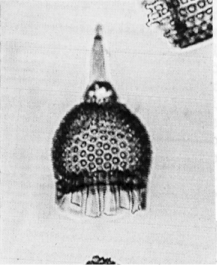 Calocyclas
hispida (Ehrenberg)
Calocyclas
hispida (Ehrenberg) Calocyclas
hispida (Ehrenberg)
Calocyclas
hispida (Ehrenberg)Anthocyrtis hispida Ehrenberg, 1873, p.216; 1875, pl.8, fig.2
Cycladophora hispida (Ehrenberg), Riedel and Sanfilippo, 1970, p.529, pl.10, fig.9; 1971, p.1593, pl.3B, figs.10-11; Moore, 1971, p.741, pl.4, figs.6-7
Two segmented theoperid with 15-25 lamellar feet or teeth surrounding the thoracic aperture. Cephalis spherical, poreless or with a few small pores, bearing a slender conical horn of variable length. The tip of the horn sometimes appears roughened. Thorax subhemispherical with small subcircular pores, quincuncially arranged with the longitudinal axis of the quincunx horizontal, giving the pores the appearance of being longitudinally arranged. In later forms the thoracic pores become more regularly longitudinally arranged. In some specimens the surface can be quite thorny, and in thick-walled specimens the pore frames are commonly hexagonal. The distal part of the thorax is surrounded by 15-25 subparallel lamellar feet or teeth. Early forms have narrower more widely spaced lamellar teeth around the apertural margin (Sanfilippo, unpublished).
Based on 35 specimens throughout its long stratigraphic range, from the Pacific, Indian and Atlantic Oceans. Total length (excluding horn): 115-215 µm; length of cephalothorax 90-150 µm. Thoracic width 90-140 µm. Horn usually broken, but when observed complete its length is 10-115 µm (Sanfilippo, unpublished).
C. hispida is distinguished from its descendant C. turris by its lamellar feet not being joined by bars to form an abdomen, and from other similar theoperids by the lamellar feet being subparallel, not diverging distally (Sanfilippo, unpublished).
This long ranging species varies in thoracic size and in the thoracic pores becoming more regularly longitudinally arranged in later forms. Early forms are within the smaller size-range, and have narrower more widely spaced lamellar feet. In thick-walled specimens the pore frames are commonly hexagonal, and the surface may be thorny. This species is rare in the early part of its stratigraphic range, becoming more common in the later part (Sanfilippo, unpublished)
Middle to low paleolatitudes from the early Eocene Buryella clinata Zone through the late Eocene Calocyclas bandyca Zone.
The ancestry of Calocyclas hispida is yet unknown. In the late Eocene it gave rise to C. turris.